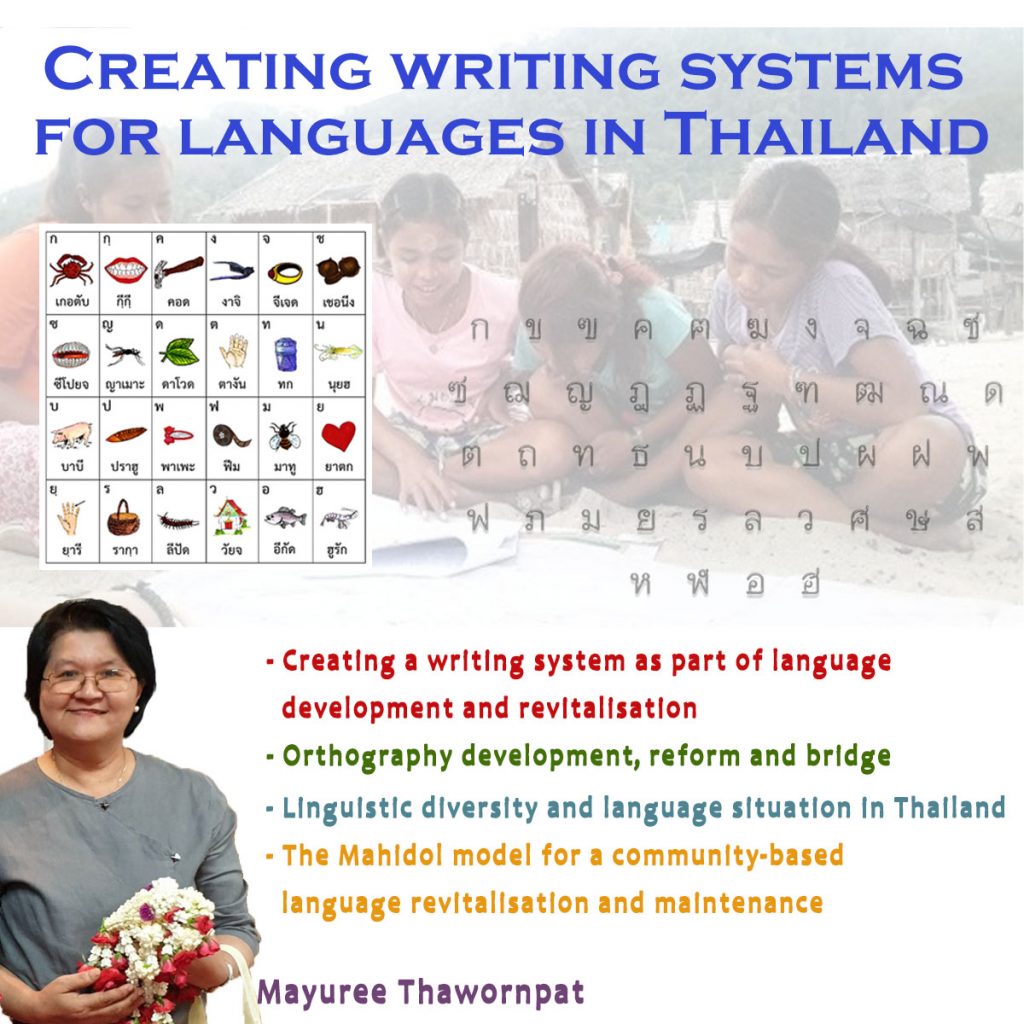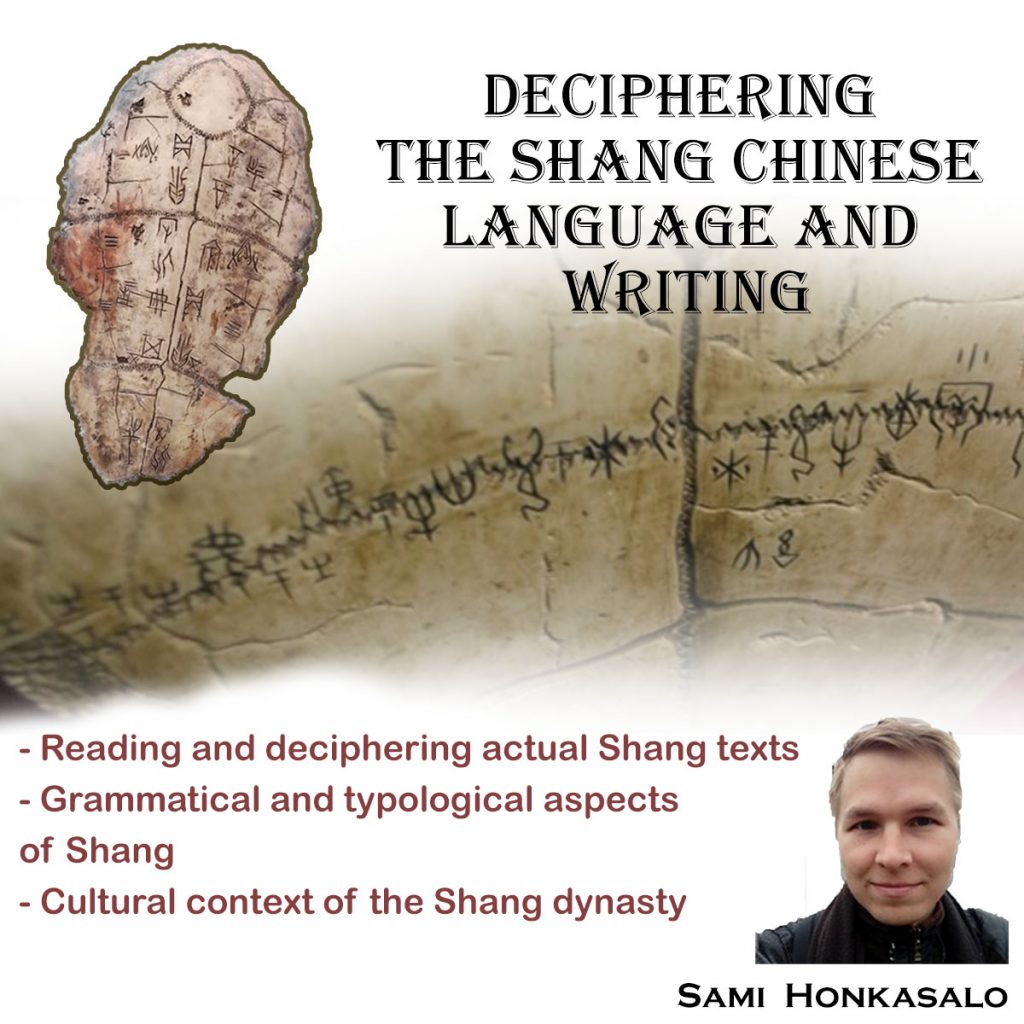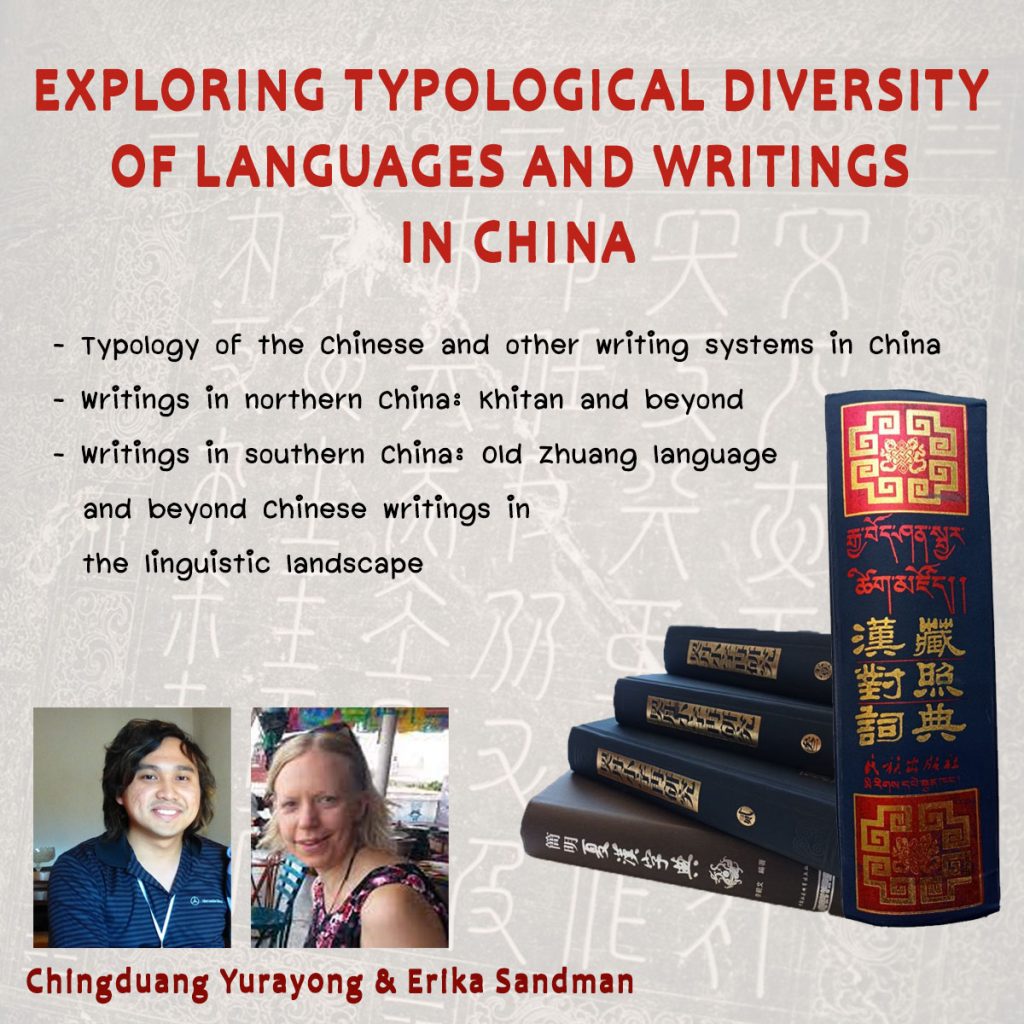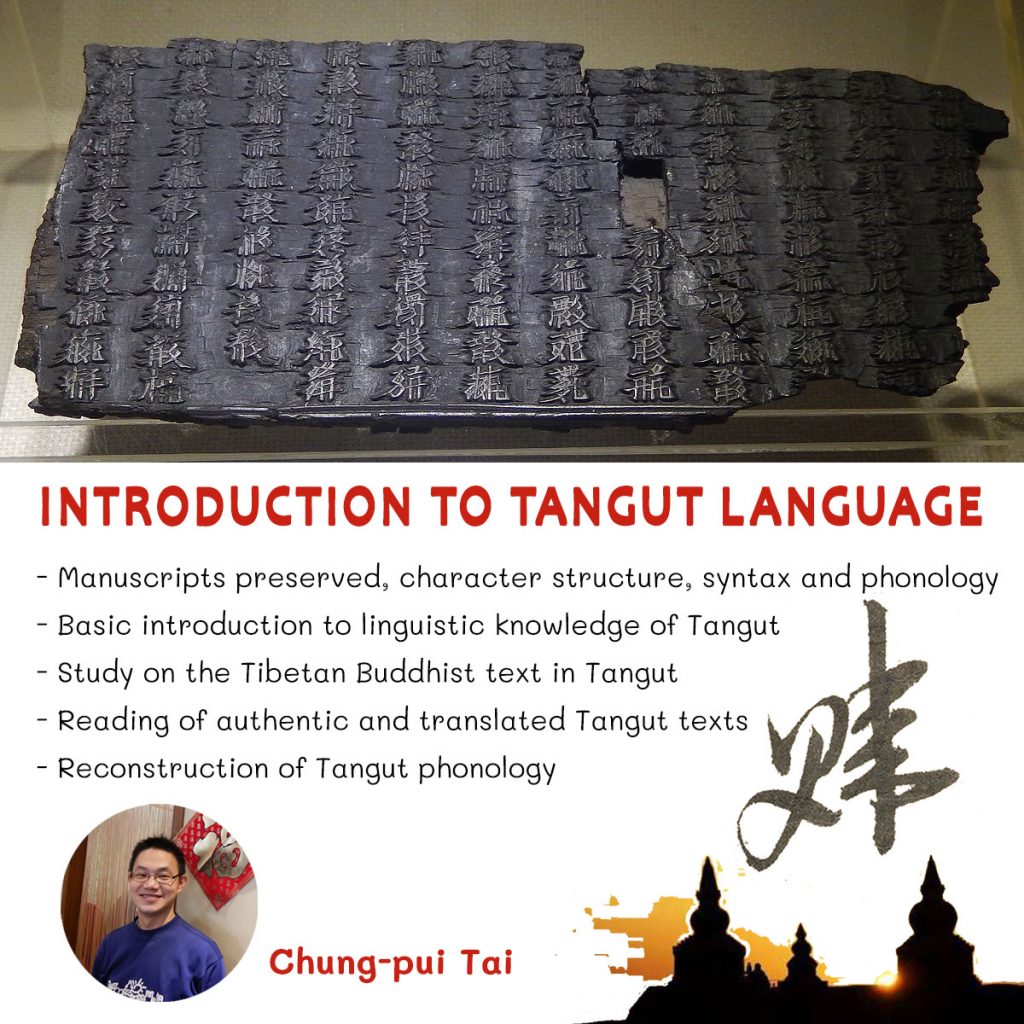Timetable
| GMT+7 (Bangkok) | Thailand track | China track |
| 9:00-10:40 | 1. Creating writing systems for languages in Thailand | 3. Deciphering the Shang Chinese language and writing |
| 10:40-10:50 | Coffee break | Coffee break |
| 10:50-12:30 | 2. Studying and preserving ancient manuscripts in Thailand | 4. Exploring typological diversity of languages and writings in China |
| 12:30-13:30 | Lunch | Lunch |
| 13:30-15:35 | 5. Introduction to Tangut language and writing (no class on Thursday 16 June) |
Participants can customise their personal programme by combining courses of their interest in and across the study tracks.

1. Creating writing systems for languages in Thailand
Teacher: Mayuree Thawornpat (Mahidol University)
The course introduces participants to linguistic diversity and language situation in Thailand, and to the Mahidol model for a community-based language revitalisation and maintenance, which concerns creating a writing system as part of language development and revitalisation, and processes within orthography development, reform and bridge.
Requirement
Some prior basic knowledge of sociolinguistics could be advantage and make the learning experience more fruitful.
Literature
Premsrirat, Suwilai. (2007). Endangered Languages of Thailand. International Journal of Sociology of Language, 186, 75-93. https://doi.org/10.1515/IJSL.2007.043.
Premsrirat, Suwilai, & Hirsh, David (Eds.). (2018). Language Revitalization: Insights from Thailand. Bern: Peter Lang. https://www.peterlang.com/document/1057090.

2. Studying and preserving ancient manuscripts in Thailand
Teacher: Yuttaporn Naksuk (Mahidol University) & U-tain Wongsathit (Silpakorn University)
The course explores ancient scripts and manuscripts found in Thailand and gives overview on epigraphic studies of ancient manuscripts up-to-date. Learning activities include a daily hands-on workshop on basics in preservation processes of ancient manuscripts with systematic metadata.
- Day 1 – Types of writing system in Thailand and metadata > practice of Tai writing systems
- Day 2 – Types of ancient manuscripts found in Thailand > manuscript and material inspection
- Day 3 – Equipment and processes of traditional and digital preservation of ancient manuscripts > cleaning and archiving
- Day 4 – Inscriptions and rubbing techniques > rubbing
- Day 5 – Issues in epigraphical studies and analysis > museum/temple visit
Sample teaching of ancient manuscript preservation (in Thai)
Requirement
Some prior basic knowledge of writing systems derived from the Indic scripts is recommended but not strictly required.
Literature
Grabowsky, Volker (Ed.). (2022). Manuscript Cultures and Epigraphy of the Tai World. Chiang Mai: Silkworm Books. https://silkwormbooks.com/products/manuscript-cultures-and-epigraphy-of-the-tai-world.
Igunma, Jana. (2013). Aksoon Khoom: Khmer Heritage in Thai and Lao Manuscript Cultures. Tai Culture, 23, 25-32. http://www.cambosastra.org/wp-content/uploads/2016/01/Khmer-Heritage-in-Thai-and-Lao-Manuscript-Cultures.pdf.
Skilling, Peter, & Pakdeekham, Santi. (2018). Manuscripts in Central Thailand: Samut Khoi from Phetchaburi Province. Manuscript Studies, 2(1), Article 5. https://repository.upenn.edu/mss_sims/vol2/iss1/5.

3. Deciphering the Shang Chinese language and writing
Teacher: Sami Honkasalo (Nazarbayev University)
The course offers an introduction to the oracle bone inscriptions and the Shang Chinese language, the earliest attested form of the Chinese language. It is aimed for participants who study the subject for the first time with little or no prior knowledge. The course is of particular interest for those interested in the history of the Chinese writing and language in their earliest stages. It offers practical training in deciphering and reading actual texts from the Shang dynasty and introduces many major grammatical and typological aspects of the Shang Chinese language. In a limited fashion, some relevant cultural aspects of the Shang dynasty necessary for understanding the texts are also discussed during the lectures.
Requirement
Some prior basic knowledge of the Chinese language and writing system is recommended, since the topics of the course are strongly related to the history of the Chinese writing system. No full fluency in Modern Chinese is required to benefit from the course.
Literature
Keightley, David. (1978). Sources of Shang History: The Oracle-bone Inscriptions of Bronze Age China. Berkeley, Los Angeles & London: University of California Press. [Google Books].
Takashima, Ken-ichi. (2017). Shāng 商 Chinese, Textual Sources and Decipherment. In Rint Sybesma et al. (eds.), Encyclopedia of Chinese Language and Linguistics Vol 4: Shā–Z, 5–22. Leiden: Koninklijke Brill. [Academia].

4. Exploring typological diversity of languages and writings in China
Teacher: Erika Sandman (University of Helsinki) & Chingduang Yurayong (Mahidol University)
The course introduces participants to a variety of languages and writings in China. It discusses typology of writing system in general, before proceeding to examining the typology of the Chinese and other systems, which are adopted to write Chinese vernaculars in Northwest China as well as non-Sinitic languages such as Khitan an Zhuang. The course also touches upon the topic of linguistic landscape, exploring the use of Chinese writings in various urban areas, including not only China but also Chinese quarters in Southeast Asia.
- Day 1 – Typology of writing system
- Day 2 – Typology of the Chinese writing system
- Day 3 – The Old Zhuang language and writing
- Day 4 – The Khitan language and writing
- Day 5 – Chinese writings in the linguistic landscape
Requirement
Some prior basic knowledge of the Chinese language and writing system is recommended but not strictly required.
Literature
Coulmas, Florian. (2003). Writing Systems: An Introduction to their Linguistic Analysis. Cambridge: Cambridge University Press. [Google Books].
Handel, Zev. (2019). Sinography: The borrowing and adaptation of the Chinese script. Leiden: Brill. [Google Books].

5. Introduction to Tangut language
Teacher: Chung-pui Tai (The University of Hong Kong)
The course focuses on features of the Tangut language and Tangut script. The contents include examples of original and translated Tangut texts, an introduction to Tangut syntax and to the structure of Tangut characters, as well as an overview of the reconstruction of Tangut phonology.
- Day 1 – Tangut language and its character writing; Tangut text reading: Ode to the inventor of Tangut characters; How to type Tangut characters on a computer
- Day 2 – The reconstruction of Tangut phonology; Tangut text reading: vocabulary from the Tangut-Chinese bilingual glossary Pearl in the Palm
- Day 3 – Syntactic features of the Tangut language; Tangut text reading: short stories “The Mother of Mencius does not deceive her son” and “The sun is near and Chang’an is far” from The Forest of Categories
- Day 4 – Discovery and preservation of Tangut manuscripts; Tangut text reading: The petition letter of the vice commander of Khara-Khoto in 1225 AD
- Day 5 – Buddhist terminology in the Tangut language; The study of Tibetan Buddhist texts in Tangut; Tangut text reading: The Tangut version of the Heart Sutra
Requirement
Some prior basic knowledge of writing systems derived from the Chinese scripts is recommended but not strictly required.
Literature
Bójūn, Sūn, & Tai, Chung-pui. (2012). Features of the Tangut consonant system as reflected in Sanskrit-Tangut transliterations. In Medieval Tibeto-Burman Languages IV, 347-381. Leiden: Brill. https://doi.org/10.1163/9789004233454_013.
Gong Hwang-cherng. (2003). Tangut. In R. J. LaPolla & G. Thurgood (Ed.), The Sino-Tibetan Languages, 602-620. London: Routledge.
Shi Jinbo. (2020). Tangut Language and Manuscripts: An Introduction. Leiden: Brill.
Tai, Chung-pui. (2018). Tibetan Buddhism practice of inner fire meditation as recorded in Tangut fragments with Tibetan phonetic glosses. Journal of Chinese Writing Systems, 2(3), 163-184. https://doi.org/10.1177/2513850218781514.
